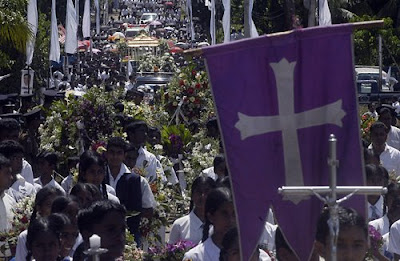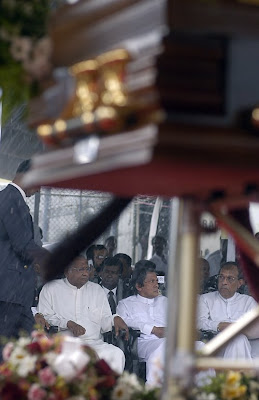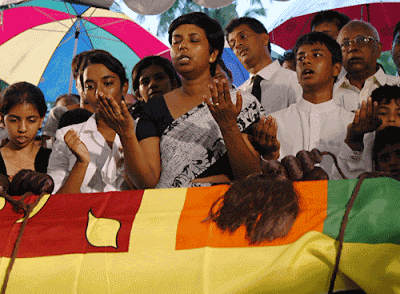Sri Lanka military liberation of Wanni (in the North) from the Tamil Tigers (LTTE). 09 April 2008.
Friday, April 11, 2008
Video: Wanni Operation - 09 April 2008
Posted by media at 11:46 AM 0 comments
'SPORT for TERRORISM' : LTTE sets new example
Tamil Tigers (LTTE) had been setting new examples in terrorism in the past. They established the craft of using suicide bombs to the world. Most of LTTE suicide bomb missions have utilized women. LTTE has been identified as a terrorist organization having the highest number of child soldiers in their military wing.
They have already killed leaders of two countries including Rajeev Gandhi, former prime minister of India and R. Premadasa, former president of Sri Lanka. They have killed large number of democratically elected politicians in Sri Lanka. In the past, LTTE have killed hundreds of Buddhist monks in cold blood in various incidents.
Ever since first Olympic game was held, sport had been considered to be symbolic gesture of world peace and harmony. Now LTTE has set another example for world terrorist organizations to follow:
LTTE suicide cadre has blown himself at a sports event killing 14 civilians including the Minister of Highway and Road Development of Sri Lanka, Jeyaraj Fernandopulle, who attended for the starting ceremony of marathon race. Mr. Jeyaraj Fernandopulle was a TAMIL himself and a CATHOLIC Christian. K.A. Karunarathna, the Olympian marathon runner and South Asian marathon gold medalist, and Luxman Alwis, the national athletic coach of Sri Lanka, were among killed in this covered act. The most of the innocent people killed in the incidents are the athletes participated in the marathon event itself.
This time LTTE has set another example for world terrorist organizations by using a suicide bomber pretend to be an athlete at a SPORTS event.
Now the whole world has a new challenge when organizing sport events. Every time LTTE terrorists invent a new terrorism mechanism, it is not only Sri Lankans but the entire world is presented with new challenge for guard against barbaric terrorist strategy.
Courtesy: Several sources
Posted by media at 11:38 AM 0 comments
Thursday, April 10, 2008
Transport of essential items to un-cleared areas continues
WANNI: EIGHTY NINE (89) lorry loads of food and other essential items had been dispatched to un-cleared areas in the Northern Province during the period between 28 March to 3 April 2008.
Those consignments had reached areas in KILINOCHCHI and MULLAITIVU districts via OMANTHAI and UYILANKULAM Entry/Exit points.
The stocks contained rice, dhal, dried fish, clothes, fuel, spices, building materials, vehicle spare parts, medicine and the such like which are needed for the use of civilians in un-cleared areas.
A total of 3734 civilians had crossed over to the un-cleared areas through those checkpoints while an estimated 3494 civilians had arrived in VAVUNIYA from un-cleared areas during the said period.
Posted by media at 9:40 PM 0 comments
MOU signed for construction of Oluvil port
Sri Lanka Ports Authority (SLPA) and the Danish contractor Mt Hojgaard have signed a Memorandum of Understanding (MOU) for the construction of Oluvil Port Project in Sri Lanka.
The Euros 46.1 project is due to take 27 months to implement.
The Oluvil Port Development Plan includes construction of a commercial port and a basin for fishing vessels.
The project will be undertaken in two phases. During the first phase, two breakwaters will be constructed.
During the second phase, dredging will be undertaken to enable the port to handle vessels of up to 16,000 tons.
Posted by media at 12:17 PM 0 comments
Wednesday, April 9, 2008
Video: Indian Parliament - Sri Lanka is better?
Brawl In Indian Parliament. Who said Our Parliamentarians are rascals?
Posted by media at 9:26 PM 0 comments
Video: Wanni Operation - 07 April 2008
Sri Lanka military liberation of Wanni (in the North) from the Tamil Tigers (LTTE). 07 April 2008.
Posted by media at 9:06 PM 0 comments
Tuesday, April 8, 2008
Faithful against the transfer of the statue of Our Lady of Madhu
 The bishop of Mannar has had the venerated image moved because of the escalation of fighting between the army and Tigers in the area of the sanctuary. Catholics are asking why he chose an area under the complete control of the rebels, and hypothesise pressure.
The bishop of Mannar has had the venerated image moved because of the escalation of fighting between the army and Tigers in the area of the sanctuary. Catholics are asking why he chose an area under the complete control of the rebels, and hypothesise pressure.
Colombo (AsiaNews) - Many Catholics in Sri Lanka, devoted to the Virgin Mary, disapprove of the decision of the bishop of Mannar to move the statue of Our Lady of Madhu to the church of Thevanpitti, at the northernmost border of the diocese. The decision of Bishop Rayappu Joseph - carried out last April 4 - is the epilogue of a drama that for months has been afflicting the local Church and the pilgrims who, in great numbers and from all the ethnic and religious groups, come to the famous shrine of Madhu. The area has become the theatre of escalation of the military confrontation between the army and the Tamil Tiger rebels. So after many appeals for better security, the bishop decided to move the venerated image of the Virgin Mary. But instead of selecting a place under the control of the army, he chose an area farther into the interior and completely under the control of the Liberation Tigers of Tamil Eelam (LTTE). The decision met with disappointment from the faithful, who are now asking "whether the bishop trusts more in the rebels, whether the shrine is the property of the government, of the LTTE, of the diocese, of the Tamils, or is not simply the heritage of all the pilgrims?".
Interviewed by AsiaNews on the topic, some Catholics in Colombo expressed their doubts and called upon the bishops' conference to act in a more decisive manner. "The responsibility for protecting a sacred place", says one woman at the shrine of Saint Anthony in Colombo, "belongs to the entire Church, and not only to the bishop of Mannar. It is the bishops' conference that must open a direct dialogue with the Tigers and the government, and this is not a political affair". "We do not understand why bishop Rayappu Joseph took this decision", say Mr and Mrs Nicholas. "It seems that the bishop acted under pressure from the rebels, otherwise we are sure that he would have moved the statue to his house or to a parish in an area already 'cleared' by the government forces". This opinion is also shared by the commander of the army, General Sarath Fonseka, according to whom the transfer of the statue is proof that the LTTE "are losing control of the area of Madhu", and, aware of their imminent defeat, are exerting pressure on the bishop and the local clergy.
There are also some among the Catholics in Colombo who maintain that if the bishop has taken this decision in the interest of the community, "he has acted for the best".
The image of the Virgin Mary at the shrine of Madhu, 220 kilometres north of Colombo, has been venerated for 400 years. Until just a few years ago, it was always considered by the warring parties as a "free zone" and was spared from violence. In recent years the area was also a refuge for families, both Tamil and Sinhala, fleeing the civil war.
Posted by media at 8:25 PM 0 comments
Washington Times: Sri Lankan rebels set up U.S. branch
 by Jen Haberkorn, Washington Times
by Jen Haberkorn, Washington Times
The Tamil Tigers, a terrorist organization whose suicide bombings and political assassinations have killed 4,000 people in the past two years, have quietly established a U.S. presence to help bankroll and equip its brutal secessionist campaign in Sri Lanka, authorities said.
Formally known as the Liberation Tigers of Tamil Eelam (LTTE) and designated as terrorists by the State Department in 1997, the group has sought for more than three decades to violently overthrow the Sri Lankan government and create an independent state for the Tamil minority.
To that end, its political wing has established "branches" in at least 12 countries, including the United States, as part of a global expansion in which the LTTE seeks to purchase millions of dollars worth of anti-aircraft weapons, automatic rifles, grenade launchers, ammunition, explosives and other military equipment, according to federal law-enforcement authorities.
That expansion has included operations in Maryland, New York and New Jersey in an effort to help raise cash and procure weapons.
A criminal complaint filed in federal court in New York in April 2007 in the arrest of a senior LTTE member in the United States said he raised money and arranged meetings between U.S. financial backers and the organization's senior leadership in Sri Lanka.
The 32-page document said the LTTE relied on "sympathetic Tamil expatriates" in the U.S., Canada, Britain, Australia, France and other countries to raise and launder money; smuggle arms, explosives, equipment and technology to Sri Lanka; obtain intelligence about the Sri Lankan government; and spread propaganda.
Yesterday, a suspected Tamil Tiger suicide bomber hit a marathon event in Sri Lanka, killing the apparent intended target, senior highways minister Jeyaraj Fernandopulle, 13 others and wounding 100 as the blast struck amid athletes, officials and spectators.
Described by the FBI as one of the "most dangerous and deadly" extremist organizations in the world, the LTTE grabbed the attention of U.S. authorities in August 2006 when eight people were charged in the New York case with conspiracy to provide resources and material support — including Russian-made SA-18 surface-to-air missiles, missile launchers and AK-47 assault rifles — to terrorist associates in Sri Lanka.
The complaint said the weapons were to be used in a "rapidly escalating conflict against the Sri Lankan military," and the U.S. operatives were acting at the direction of the organization's senior leadership. A separate complaint said they also sought to obtain classified information and conspired to bribe U.S. public officials to remove the LTTE from the State Department's list of Foreign Terrorist Organizations.
With an estimated 7,000 combatants, the Tigers control much of the northeastern coastal areas of Sri Lanka, an island nation 20 miles off the southern coast of India.
"Its ruthless tactics have inspired terrorist networks worldwide, including al Qaeda in Iraq," the FBI said in a recent profile, adding that the group had "placed operatives right here in our own back yard, discreetly raising money to fund its bloody terrorist campaign overseas."
The U.S. operatives have raised funds under a variety of cover organizations, often posing as charities, the FBI said, adding that "a great deal of money" was raised after the 2004 tsunami that devastated Sri Lanka and many other countries.
Last year, FBI agents in New York arrested Karunakaran Kandasamy, described as the "director" of U.S. operations, accusing him of raising money and arranging meetings between LTTE leaders in Sri Lanka and prominent U.S. fundraisers.
FBI Assistant Director Mark J. Mershon, who heads the bureau's New York field division, said at the time Mr. Kandasamy "hasn't merely supported the Tamil Tigers' cause, he orchestrated U.S. support.
"We can no sooner allow terrorists to raise funds here than we would allow them to carry out acts of terrorism here," he said.
U.S. Attorney Roslynn R. Mauskopf, in announcing Mr. Kandasamy's arrest, said he operated out of an office in Queens, where he raised cash by staging fundraisers for tsunami victims through an organization known as the World Tamil Coordinating Committee.
Mrs. Mauskopf said the LTTE has "covertly operated within the United States" for years, drawing on the country's financial resources and technological advances to further its war of terror. She said the organization had undertaken a major worldwide campaign to raise money for its offensive against the Sri Lankan government.
In Maryland, Thirunavukarasu Varatharasa, a Sri Lankan national, was sentenced in January to 57 months in prison on charges of conspiracy to provide support to the LTTE and the attempted exportation of arms and munitions. In a sting operation, he and three others negotiated to buy a laundry list of weapons from an undercover business in Baltimore.
A criminal complaint said Varatharasa conspired to export $900,000 worth of machine guns, ammunition, surface-to-air missiles, night-vision goggles and other military weapons to Sri Lanka. A co-conspirator, Haniffa Osman, who lives in Singapore, even traveled to Baltimore to test fire some of the weapons at a range in Havre de Grace with undercover U.S. Immigration and Customs Enforcement (ICE) agents.
A plea agreement in the case said if delivery of the first purchase was successful, undercover ICE agents were assured that a second order could be worth as much as $15 million.
"They had a well-organized establishment, but working with the Joint Terrorism Task Forces, we took a good bite out of them with the last several cases," said FBI spokesman Richard Kolko in Washington.
However, he said the Tigers have "more fundraising and organizational desires" in the United States.
"Fortunately, we haven't seen a strong will to attack in the U.S., but that's not [impossible]," he said. "That's why we have to stay on top of it."
In the Maryland case, the plea agreement said Varatharasa and the others negotiated the purchase with undercover agents at a Baltimore business of 53 military weapons for the LTTE in Sri Lanka. It said they later met in Saipan with the undercover agents to inspect several machine guns and sniper rifles they had ordered in Baltimore.
After the inspection, a deal was made to transfer the money into an undercover bank account in Maryland. None of the weapons were ever delivered.
The FBI credits the LTTE with perfecting the use of suicide bombers and being the first to use women in suicide attacks. It also is the first terrorist group to assassinate two world leaders — former Indian Prime Minister Rajiv Gandhi in 1991 and the 1993 assassination of the Ranasinghe Premadasa, president of Sri Lanka.
Peter Chalk, senior terrorism and insurgency analyst at Rand Corp., said the LTTE may have learned a lesson from the U.S. arrests and pulled its operatives out. He said the U.S. venture was "probably an experiment," adding that the group is "smart enough to learn from its mistakes."
Mr. Chalk also noted that the LTTE has "always had a large, prolific international network" and has been "quite prolific in Canada for fundraising."
Canada is home to many former Sri Lankans, and Canadian authorities said the organization has blackmailed many of the expatriates for money, threatening to harm relatives at home.
Posted by media at 1:53 AM 0 comments
Monday, April 7, 2008
Sri Lanka's slain minister of Highways and Road Development Jeyaraj Fernandopulle
 Members of the Sri Lankan Parliament bring in the coffin of slain minister of Highways and Road Development Jeyaraj Fernandopulle, into his residence in Colombo, Sri Lanka, Sunday, April 6, 2008. A suicide bomber attacked the opening ceremony of a marathon outside Sri Lanka's capital Sunday, killing the government minister and 11 other people, authorities said. Dozens were wounded.
Members of the Sri Lankan Parliament bring in the coffin of slain minister of Highways and Road Development Jeyaraj Fernandopulle, into his residence in Colombo, Sri Lanka, Sunday, April 6, 2008. A suicide bomber attacked the opening ceremony of a marathon outside Sri Lanka's capital Sunday, killing the government minister and 11 other people, authorities said. Dozens were wounded.
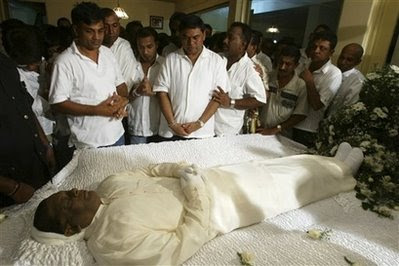 Members of the Sri Lankan Parliament pay final respect to the slain minister of Highways and Road Development Jeyaraj Fernandopulle, at his residence in Colombo, Sri Lanka, Sunday, April 6, 2008. A suicide bomber attacked the opening ceremony of a marathon outside Sri Lanka's capital Sunday, killing the government minister and 11 other people, authorities said. Dozens were wounded.
Members of the Sri Lankan Parliament pay final respect to the slain minister of Highways and Road Development Jeyaraj Fernandopulle, at his residence in Colombo, Sri Lanka, Sunday, April 6, 2008. A suicide bomber attacked the opening ceremony of a marathon outside Sri Lanka's capital Sunday, killing the government minister and 11 other people, authorities said. Dozens were wounded.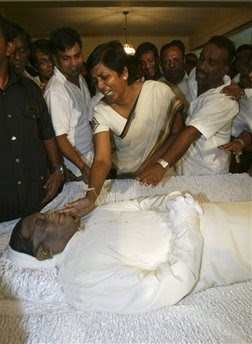 Sudarshani, center, wife of Sri Lanka's slain minister of Highways and Road Development Jeyaraj Fernandopulle, weeps over his body at their residence in Colombo, Sri Lanka, Sunday, April 6, 2008. A suicide bomber attacked the opening ceremony of a marathon outside Sri Lanka's capital Sunday, killing the government minister and 11 other people, authorities said. Dozens were wounded.
Sudarshani, center, wife of Sri Lanka's slain minister of Highways and Road Development Jeyaraj Fernandopulle, weeps over his body at their residence in Colombo, Sri Lanka, Sunday, April 6, 2008. A suicide bomber attacked the opening ceremony of a marathon outside Sri Lanka's capital Sunday, killing the government minister and 11 other people, authorities said. Dozens were wounded.
Posted by media at 8:37 AM 0 comments
Sunday, April 6, 2008
Video: LTTE kills Tamil, Catholic Minister Jeyaraj Fernandopulle in suicide bomb
Tamil Tigers (LTTE) killed another Tamil politician in a suicide bomb blast. Minister Jeyaraj Fernandopulle was killed following the blast in Welliweriya, Gampaha this morning. The blast occurred when he was about to flag off a marathon run as part of a Sinhala-Hindu New Year celebration event.
Being a faithful Catholic, the Tamil Minister expressed his concerns over LTTE's occupation of scared Madhu church and the removal of the Madhu statue recently.
A lawyer by profession, Minister Jeyaraj Fernandopulle began his political career in 1970 as a SLFP polling agent. Fourteen years later in 1984 he was appointed as the SLFP chief organizer of the Katana electorate. He successfully contested the 1989 parliamentary election from the seat and ever since then elected to the parliament five consecutive times in the years 1989, 1994, 2000, 2001 and 2004. By the time of his death he was the Chief Government whip and a Cabinet Minister. He had also been appointed the UPFA organizer for the Trincomalee district for the forthcoming provincial council elections in the East.
Veteran marathon runner K.A Karunarathne, who was a national and South Asian marathon gold medalist, is also said to be among the dead. Karunarathne represented Sri Lanka at the Barcelona Olympics in 1992.
Posted by media at 10:02 AM 1 comments

